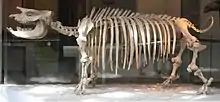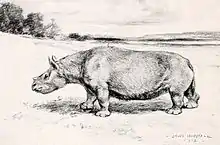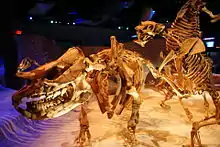Teleoceras
Teleoceras is an extinct genus of grazing rhinoceros. It lived in North America during the Miocene and Pliocene epochs during the Hemingfordian to the end of Hemphillian from around 17.5 to 4.9 million years ago.[4][5]
| Teleoceras | |
|---|---|
 | |
| Specimen at the Natural History Museum of LA | |
| Scientific classification | |
| Kingdom: | Animalia |
| Phylum: | Chordata |
| Class: | Mammalia |
| Order: | Perissodactyla |
| Family: | Rhinocerotidae |
| Genus: | †Teleoceras Hatcher, 1894 |
| Type species | |
| †Teleoceras major | |
| Species[1] | |
| |
| Synonyms | |
Description


Teleoceras had much shorter legs than modern rhinos, and a barrel chest, making its build more like that of a hippopotamus than a modern rhino. Osborn based on this, suggested in 1898 that it was semi-aquatic and hippo like in habits. This idea persisted for around a century, but has recently been discounted by isotopic evidence.[5] Teleoceras is now thought to have been a terrestrial grazer on C3 plants.[5] Teleoceras had a single small nasal horn.[6]
Discovery
Teleoceras is the most common fossil in the Ashfall Fossil Beds of Nebraska. In fact, its remains were so numerous and concentrated that the building housing the greatest concentration of Ashfall fossils is called the "Rhino Barn". Most of the skeletons are preserved in a nearly complete state. One extraordinary specimen includes the remains of a Teleoceras calf trying to suckle from its mother.[7] This animal was featured in the episodes "Are Rhinos Dinos?" and "Dawn Of The Cats" of the Paleoworld series.
Extinction
Teleoceras went extinct in North America alongside Aphelops at the end of the Hemphillian, most likely due to rapid climate cooling, increased seasonality and expansion of C4 grasses, as isotopic evidence suggests that the uptake of C4 plants was far less than contemporary horses.[5]
References
- Prothero, 2005, p. 94.
- McKenna & Bell, 1997, p. 483.
- Prothero, 2005, p. 122.
- (Prothero, 2005)
- Wang, B.; Secord, R. (2020). "Paleoecology of Aphelops and Teleoceras (Rhinocerotidae) through an interval of changing climate and vegetation in the Neogene of the Great Plains, central United States". Palaeogeography, Palaeoclimatology, Palaeoecology. 542. doi:10.1016/j.palaeo.2019.109411.
- Palmer, D., ed. (1999). The Marshall Illustrated Encyclopedia of Dinosaurs and Prehistoric Animals. London: Marshall Editions. p. 265. ISBN 1-84028-152-9.
- Ashfall Fossil Beds
Bibliography
External links
| Wikimedia Commons has media related to Teleoceras. |